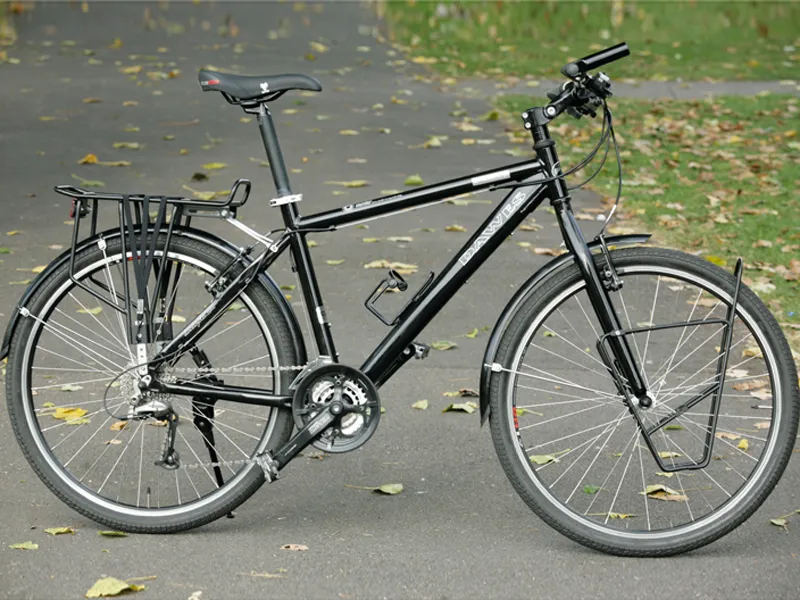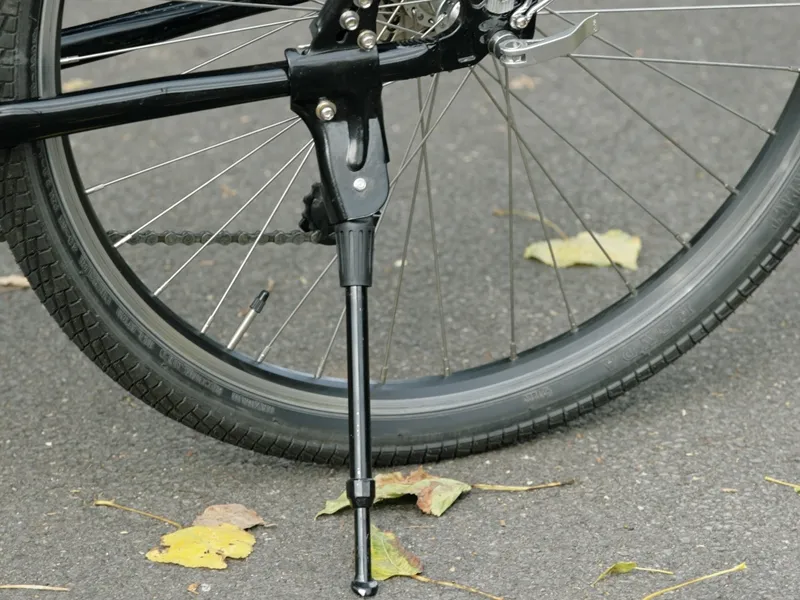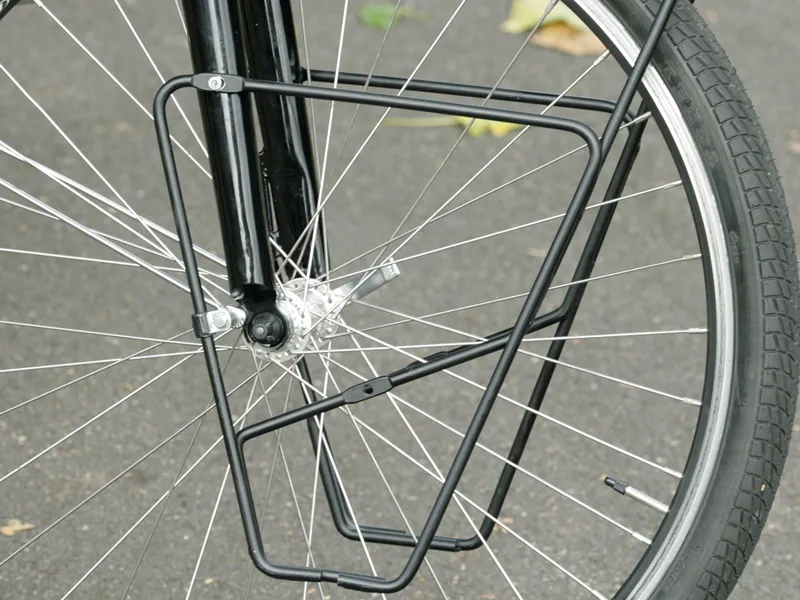The last time we tested a Dawes Sardar it was a very different beast. It looked every inch a classic steel tourer, from its Reynolds 631 tubes to its drop handlebars. But in the modern manner of things, this year's Sardar has had a makeover. However, unlike contestants on TV transformation shows - though maybe in sympathy with the average non-cyclist - it's gained weight as well as changed shape. On the plus side, the price has gone down: the RRP is now a shade under five hundred quid, but you can easily pick it up for less.
Gone is the elegant steel frame, as are the drop bars. The wheels still boast 26in rims - the ubiquitous, sensible choice for a touring or expedition steed - but this machine has mountain bike heritage, not touring bike. From the extra wide bars to the ultra chunky aluminium frame complete with gusset, this cries out Mtb-cum-tourer. But it's certainly not without its qualities: the virtually all black frame complemented by mainly black components, albeit from a variety of sources, looks good. But do they overcome the new Sardar's sumo wrestler's weight?
>Frame >The first thing you notice when you pick up the Dawes Sardar is the weight - this is a heavy bike. The welds are neat and the black finish is first rate, certainly better than some Dawes bikes that we've seen in recent years. But while the frame boasts the slogan 'Dawes Specific Touring Technology', you can't help but feel this claim doesn't really mean that much.
If you compare the Sardar's frame with Dawes' mountain bikes, you'll find it boasts very similar proportions and profiles to one that's matched with suspension forks. This isn't necessarily a bad thing - an off-road machine needs to be strong enough to cope with differing surfaces - but it does seem excessive on a tourer. And this certainly has touring intentions, the frame boasting three sets of bottle bosses for instance. One unforeseen corollary of this bike's set-up - the short top-tube and gusseted down-tube - is that it was impossible for me to get my Squire shackle lock through wheel and frame, let alone through an immovable object.
Forks are steel, again with the emphasis on strength over light weight. Overall the frame and fork combo is a real black beauty, but - stretching the equine analogy to breaking point - it's more shire horse than Derby or Grand National competitor.
>Handling >As befits a bike of this weight, the bike handles surefootedly rather than swiftly. Load up the panniers to bursting point and there's still no wavering, so all that bulk does at least contribute to confidence-inspiring stability. Narrowing the bars a bit would, we reckon, improve the handling and reduce the vibrations transmitted through the aluminium frame - enough to cause tingling fingers after a couple of hours riding.
Steering was actually lighter than expected, while descending, even with heavy loads, was impressively reassuring: no twitches, no sketchiness, good grip and safe stopping. As with so many other areas of the Sardar, if the weight isn't an issue, then this delivers all you could expect of it. >
Wheels >No surprises here. Yep, weight and durability are the watchwords, with not even lip service paid to the trimming of ounces or pounds. The wheels combine Alex's 36-hole DH rims with Kenda's 1.75in Kontact tyres. It's good to see 36-hole rims on a touring bike; you could tour on 32-spoked hoops, but 36 does offer increased strength.
The use of 26in wheels is also sensible - these wheels are, all other things being equal, stronger than their 700c equivalents - and replacement spokes, rims, tyres and tubes will be straightforward anywhere in the world. The Kontacts performed well on the road and on rougher surfaces, though, as with other areas of the bike, unless you're carrying loads of kit, you could probably lose some weight - in this case, all-important rotating weight - by fitting a pair of lighter, slicker tyres. Unusually, for just about any bike these days, the hubs are not from Shimano, instead they're well-finished items from Formula.
>Components >There's a reasonable selection of finishing kit on the Sardar, with pride of place crucially going to the brakes, derailleurs and levers. The V-brakes offered huge amounts of stopping power and loads of control, the ideal combination when descending the steep hills around Bath during the summer rain carrying bulging panniers. The riser bars seemed excessively wide, and you could comfortably shave these down a little.
Both mechs are from Shimano's well respected off-road LX groupset. Changes were excellent but, being more used to Shimano's road STI levers, I found myself changing down rather than up, and vice versa; Cycling Plus's technical editor Paul Vincent has had the same experience. An upward push of the thumbs changes down, pushing the lever down changes up; no doubt it's just a case of getting used to them. The one area of the drivetrain that deviates from LX is the Truvativ chainset, which gives a knee-friendly low gear of 52in; this combo got me up some steep hills I'd not normally attempt on my own tourer. The bars, stem and rack are unbranded, but none gave us any cause for concern quality-wise. The rear rack even comes with very functional flat bungee cords, black of course.
You could trim some weight by whipping off the bike stand, which is handy for when you're going to the shops but less so during a full-on tour. Likewise you could remove the front rack if you're not loading up to the gills, but even then the weight reduction is only going to shave off a couple of pounds or so.
Nice to see the pedals spec on this: flat one side, SPD the other. It's the perfect choice for the type of market this is aimed at. The four-point rear rack proved pleasingly stiff, though the fitting system, while strong, seemed unnecessarily complicated.
Verdict >In short, there's loads to love about the new incarnation of the Sardar. You get a lot of bike and some good quality kit for your cash, but it's impossible not to mention the weight. True, the more gear you're carrying the less important the weight becomes but, unloaded, you can't help but notice it. This is a shame, because the ride quality is virtually faultless, steady, sure-footed and reliable.
But the question that's difficult to answer is: just who is this bike aimed at?If you're thinking of going on an extended loaded tour you'd probably be better off with a dedicated tourer, lighter in weight, more nimble handling but just as strong.
If you want one bike for multiple uses this could have its place. Buy it at a discount price, strip some of the extraneous weight and buy a lighter pair of wheels and you'd have a decent, durable everyday bike with the potential to go touring on it.





